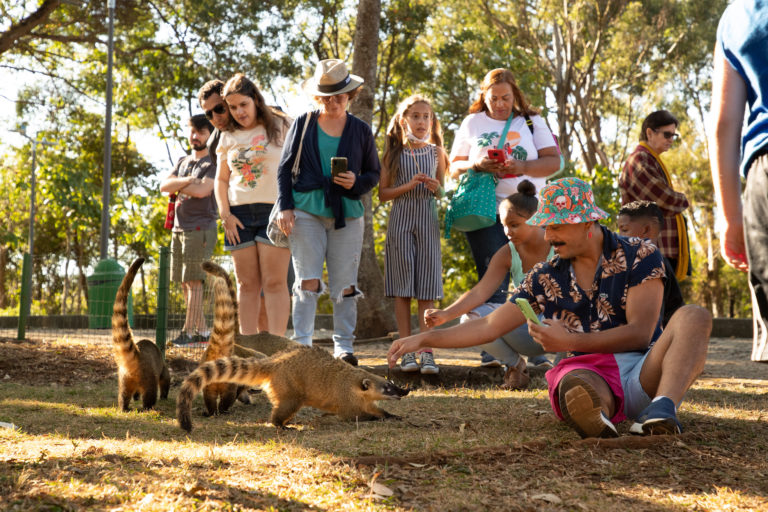- For 15 decades, the Quatis Undertaking has monitored coati populations in Belo Horizonte’s Mangabeiras Municipal Park. Interactions with readers, local people and domestic animals lead not only to greater populace density but also to the trade of health conditions among wildlife, animals and humans.
- The huge provide of human rubbish and food stuff in the park location, merged with lack of natural predators, has brought on the coatis to proliferate. Population density there is now 3 occasions bigger than in other a lot more preserved areas where they also exist.
- The Quatis Job is headed and led mainly by women. Considering that its development, a devoted team of researchers has fought for female visibility in science, fieldwork and biodiversity conservation in Brazil.
- Substantial and long lasting environmental education and learning among the the inhabitants is 1 of the handful of feasible answers for conflicts with wildlife at the Mangabeiras Park.
Feeding wild animals is a frequent pattern in Brazil. Irrespective of whether it is for the prospect to technique and observe them up close or consider a photo, or simply because of the believed that they absence ample foods in their purely natural habitat, lots of folks share some of their individual meals with native birds and mammals. Nonetheless, this seemingly harmless practice may possibly have adverse effects for the animals’ well being, in addition to triggering environmental imbalances and conflicts with people.
In Belo Horizonte, the cash of Brazil’s Minas Gerais state, the Mangabeiras Municipal Park has been remodeled into an out of doors experiment in the complex consequences of artificially feeding wildlife. With 235 hectares (580 acres), it is one particular of the largest urban parks in Latin The united states. It is positioned amongst the Mangabeiras community, dwelling to some of the city’s wealthiest citizens, and Aglomerado da Serra, a district where by countless numbers of persons are living in significant social vulnerability. The spot is greatly used as a general public leisure area.
The park is dwelling to one of the most significant recognised coati populations: about 30 persons for every sq. kilometer (77.7 for every sq. mile) — a population density three situations increased than the normal in other parts where they dwell. For 15 decades, that population has been closely monitored by the Quatis Project workforce led by biologist Nadja Simbera Hemetrio, who holds a master’s in ecology. The challenge seeks to fully grasp the origins of the unusually substantial regional coati populace as effectively as the effects of their interactions with individuals, domestic animals and the city ecosystem on their ecology and health: “We want to locate steps that carry about a healthier connection between wildlife and individuals,” the researcher suggests.

Coatis, quick foodstuff and lots of youthful
Coatis (Nasua nasua) are midsize carnivores of the Procyonidae spouse and children, which also involves raccoons and kinkajous. They are exceptionally social animals and might sort big packs. Inspite of transferring quite effectively on the ground, they are outstanding climbers and get into trees with simplicity. With their prolonged, malleable snouts, they sniff out anything less than leaves, tree bark or earth.
Coatis are purely natural inhabitants of Brazilian forests and occupy all of the country’s biomes. In the wild, they are omnivorous and feed on pretty much all the things they can uncover: fruit, seeds, insects, worms, mollusks, spiders and even vertebrates this kind of as birds, frogs, lizards and small mammals.
Obtaining any of these objects in the wild takes time and energy, and the strength return is often a lot lower than that supplied by a chocolate bar or a packet of chips, for example. This means that in the existence of human beings, finding a good deal of food items has come to be less complicated and more rapidly. For coatis, staying all around a group of vacationers to attempt modest improvements over their picnic is more rewarding than on the lookout for foods in the forest — which does not signify that there is no meals for them in their all-natural habitat.
And the geographical, social and environmental context of the Mangabeiras Park will make these possibilities much much more frequent: a lot of website visitors, snack bars, accrued rubbish and a neighborhood entire of bars, dining establishments, residences, outlets and trash barrels are ideal for coatis.

Far more food items implies much more reserves, much more strength, which can be expended in discovering new areas, wanting for greater shelter, creating safer nests from predators (yes, coatis build tree nests), defending territories and, of course, breeding and caring for the youthful. In character, larger food supplies practically often direct to population increase, as animals can afford to invest far more time and electricity in mating. In the absence of their purely natural predators these as jaguars, alligators and wolves, coatis obtain no boundaries to increasing their population.
As a result of the abundance of meals in the Mangabeiras Park region, the coatis have multiplied and turn into much more daring, relocating on to investigate adjacent parts, like the town. Above time, the situation has snowballed: they have begun to enter nearby homes, specifically in which welcoming hosts reward them with treats. Today, they climb partitions with unparalleled dexterity, get via home windows, research the rubbish and at times even enter hospitals, law enforcement stations and organizations.

Elenice Antunes owns a food truck and performs around the Mangabeiras Park, near to a substantial medical center and the Serra do Curral Park, an additional municipal region with its have coati population. She claims the coatis shell out her every day visits given that she set up her business. They have “robbed” her meals truck on various instances: they get on major of the automobile, climb on doors and windows, tear meals deals open up, knock down kitchen area utensils, rummage by means of the rubbish and run absent as rapidly as they arrived.
“Now I constantly leave the trash can in the truck, and I shut every little thing as quickly as I see them,” Antunes says. She also says the absence of common rubbish collection in the place ends up attracting wild animals and worsening the issue. “I’m fearful they might damage another person. Just one of these times, they had been climbing on a incredibly frail aged lady. A scratch by those sharp claws could very seriously injure her,” she provides.

Inhabitants study
A person of the pillars of the Quatis Venture is to understand the dynamics of the coati population in the Mangabeiras Park and adjacent locations. For this, scientists use a system named mark and recapture. “Based on the proportion of individuals marked and recaptured between subject campaigns, we are equipped to estimate the total population of a species in a particular place,” Hemetrio says. Fundamentally, it exhibits what proportion of the population is essentially sampled in the captures and what part likely escapes the researchers’ interest. Evaluating the numbers in between area campaigns, it is also probable to know how the inhabitants behaves in excess of time.
In addition to a inhabitants density 3 occasions previously mentioned the average, Hemetrio and her staff locate that, in the Mangabeiras Park, coati bands are additional quite a few and, evidently, beginning costs have a tendency to be bigger. Ladies who would commonly give beginning to two to 7 kits may perhaps have extra offspring in a condition like that — an regular of six. Mortality premiums amid the young are decreased, and the animals live more time. As coatis reproduce synchronously each individual year, the extended-time period impact can be disastrous, with a sizeable populace maximize.
Analyzes of blood samples also place to minimal genetic variability amongst the coatis from the Mangabeiras Park. In follow, this indicates they are not displacing substantially and are mating between them selves, accomplishing tiny gene trade with populations exterior the park. Hemetrio’s hypothesis is that with more substantial food items supplies, the animals began to move fewer close to the landscape. They are comfy in the park, so to converse.
The Quatis Task has captured additional than 300 persons throughout its virtually 15 many years of existence, and a lot of have by now died — that is, they are no lengthier portion of the populace. Meanwhile, some others were born and mated, satisfying their role in perpetuating the species. “Today we have a fuller photo of the habits of coatis, their inhabitants dynamics and wellness. Due to the fact we’ve been monitoring the populations of the park for a prolonged time, we have been also ready to observe the everyday living record of the animals, from beginning to loss of life,” says Hemetrio.

Risk of illness transmission
Conflicts concerning coatis and domestic animals are not unusual: stray puppies frequently enter the park, pursue and attack the coatis, in some scenarios causing genuine massacres. These kinds of get hold of is not only hazardous for equally sides but may possibly also transmit diseases and pathogens.
The project’s vets have previously discovered a collection of vectors and etiological agents in coatis, together with ectoparasites such as ticks, lice and fleas, as very well as nematodes, bacteria, viruses and hemoparasite protozoa with large zoonotic opportunity. Quite a few of these organisms are shared with domestic puppies, cats and horses, and some also pose dangers to human wellness.
They trigger or transmit diseases this kind of as spotted fever, leishmaniasis, leptospirosis, rabies, distemper, babesia and scabies. The greater the get hold of between coatis, folks and domestic animals, the greater the chances that these diseases will distribute and trigger problems to community health and fitness, this kind of as outbreaks of new epidemics.

Conservation warriors
Hemetrio applied to go to the park lengthy just before she became a biologist. Going for walks in the woods was aspect of her childhood, and when she arrived there, armed with her diploma and scientific enthusiasm, she currently understood each individual corner of the area. She started researching coatis in school, for her undergraduate thesis. Then she wrote her master’s dissertation on the exact matter and later joined the Belo Horizonte Municipal Parks and Zoological-Botanical Foundation, in which she now serves as environmental training supervisor.
“The Quatis Job is basically female-based mostly, designed and managed by girls,” she claims. Of system, quite a few males have been doing work on the venture and contributed to it around the a long time, but the mind-boggling majority of team users are females. Biologists, veterinarians, geneticists, ecologists, parasitologists, interns and area assistants — a legion of ladies decided to crack all paradigms held by pros in the industry about fieldwork and other pursuits found as “male.”
“I’m extremely grateful for acquiring contributed to the training of so many researchers and staying equipped to do the job along with these kinds of extraordinary and hardworking people today. The job has normally shown that women can tackle any occupation, and we hope it conjures up other girls who want to deliver good improve to the earth,” Hemetrio suggests.

Environmental training
A person of the most essential steps carried out by the Quatis Task is an ongoing environmental instruction plan in partnership with the Municipal Parks and Zoological-Botanical Foundation as well as the personal sector. It is made up of a strategy to converse with the inhabitants by means of talks, booklets, signals, posters, interactive pursuits, lectures, cultural activities and exhibitions that include park visitors and staff members, community people, educational institutions, professional establishments and neighborhood associations.
“Without doing work on people’s notion of coatis and their feeding habits, the issue of overpopulation will in no way be solved. All conservation assignments will have to concentrate on men and women because people create effect. There is no conservation with out individuals,” Hemetrio explains. This includes not only an expository method but also the capability to listen to what they have to say. “We check out to realize how folks see the species and the difficulty, so that we really do not arrive with our prepared-designed ideas but rather request to fill in gaps to support them.”
One of the participants of the environmental education and learning task was exactly Antunes, the meals truck operator who is effective close to the park. Now, she speaks with authority about animals and understands the complexity of the situation very nicely, so significantly so that she begun to instruct buyers and passersby on the hazards connected with feeding coatis.
The staff members of the Mangabeiras Park, who had been used to feeding the coatis for many years, are now allies of the undertaking. They not only information guests but also enable the researchers to watch the coatis, notifying the workforce about the passage of bands by way of various destinations, the range of animals in each and every band, their apparent wellbeing status and identification when obvious on the ear tags. “Local inhabitants now know us they give us with significant info about the animals they see and even aid us in environmental education, conversing to other people and elevating their awareness. It’s a ripple result,” Hemetrio clarifies with a hopeful smile on her experience.
The idea is that this ripple impact might circulation by alone 1 day and men and women impact every single other positively, with out the will need for the project’s intervention. “I’m hopeful that, about time, individuals will improve their behavior, the coatis will change their behavior, and that in the upcoming we’ll be in a position to reduce the density of animals in the Mangabeiras Park and the conflicts linked to it. This is a route that we have to hold treading, a perform that never stops,” she concludes.
Banner graphic: Coati at Mangabeiras Municipal Park, in Belo Horizonte, MG. Picture by Augusto Gomes.
This story was documented by Mongabay’s Brazil team and initial published in this article on our Brazil site on Oct. 3, 2022.
